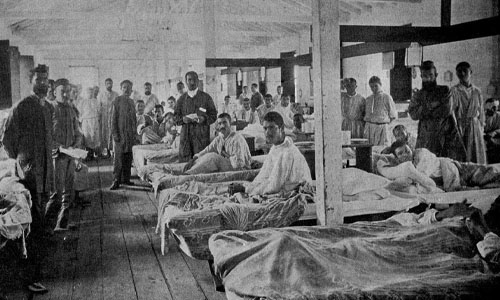Fatalities of the Spanish Army deployed in Cuba [i]
At the outbreak of Cuba’s War of Independence, (February 24, 1895), there were 20,197 Spanish soldiers in Cuba. This number proved to be insufficient. In March 1895, the first of 12 reinforcement expeditions made the journey from several Spanish ports to Cuba. In February 1898, the last contingent of 7,186 men landed on the island, bringing the total to 203,449 (including the original garrison) and making it the largest European Army ever to cross the Atlantic Ocean to America.
The war in Cuba was a burden on the impoverished Spanish economy, but despite the political and financial crisis, Spain made a remarkable effort to field a huge army in Cuba. Though large, the Army had low discipline standards, was badly trained, and the soldiers were mostly instructed in the narrow confines of the barracks’ patios. In addition, the troops fighting in the island suffered extreme health peril of tropical diseases. Cuba’s climate is dominated by the dry and the rainy seasons. The dry season was the preferred time for offensive «search and destroy» operations against the Cuban forces, highly skillful in Guerrilla war. But during the rainy season, the few existing roadways turned into soft and wet muddy roads, reducing the troops combat effectiveness, furthermore yellow fever, malaria and other deadly contagious diseases became the frightful companions of Spanish soldiers in Cuba at a time when penicillin and other antibiotics had not been discovered. Maximo Gomez, Commander in Chief of Cuban Army of Independence would say that his best generals were the months of June, July and August. He was right.


Over 55,000 Spanish soldiers died in Cuba. It was a human catastrophe that was covered up by deceiving military reports of fabricated victories. From its large supply of men, mostly poor illiterate peasants, Spain paid the staggering price of losing over 25% of those who made the transatlantic voyage to Cuba. By comparison, in World War I the United States (U.S.) lost fewer than 52,000 soldiers, in the Korean War they lost 34,000 soldiers and in the Vietnam war the U.S. lost over 58,000 soldiers.
The dreadful number of Spanish soldiers’ death in Cuba’s war is seldom mentioned in historical data, but is certainly a national tragedy. One in every four Spanish soldiers deployed to Cuba never returned to their families. They were sacrificed in the infinity of pain and suffering by the corrupted oligarchy of a decrepit empire. Andalusian poet Antonio Machado said it best “It was a time of lies and infamy”.
[i] Antonio Carrasco García .En Guerra con los Estados Unidos ediciones Almena, Madrid , 1998 pág. 199
[ii] Carrasco García opcit pg. 250










5 comentarios en “CUBA: THE WAR OF INDEPENDENCE (1895-1898)”
Very well done. Pedro, keep it going
Muy buen trabajo y me entero ahora de la cantidad de la desgraciada y lamentable cantidad de soldados españoles que murieron en el conflicto.
Muy interesantes y mayormente desconocidos datos. Ilustran la heroicidad de los mambises ante tan numeroso enemigo. Excelente relato al igual que otros en esta serie. Adelante!
Estos datos son muy interesantes, no lo sabia. Mi bisabuelo , Francisco Fernandez -Calienes providente de Asturias fue asesinado por los mambises en 1883. Era un soldado español.
What happen to those 146,788 soldiers that survived the war? I understand that the government of Spain claimed it did not have capacity to repatriate these and that the USA unilaterally decided that they should remain in Cuba with all the rights bestowed to Cubans. One these soldiers was Angel Castro y Argiz whose sons have, economically and morally, destroyed Cuba.
Los comentarios están cerrados.